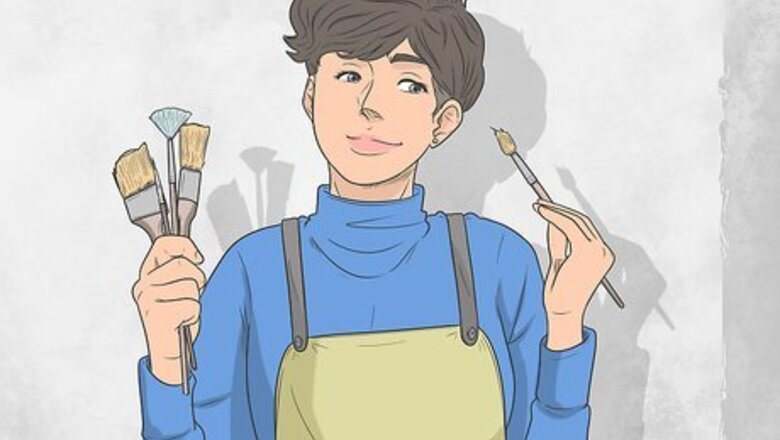
views
Setting up Your Paint and Canvas
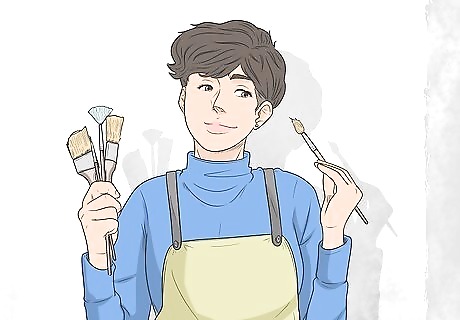
Get a variety of paintbrushes to work with. For an acrylic portrait, you’ll need bigger brushes for large areas of the skin and hair, and smaller brushes for the details, like the eyes and the lips. You may also want brushes made out of different types of hair, depending on the style you’re going for. Bristle brushes make bold, distinct strokes, which can give your portrait an impressionist look. Sable brushes make smooth, blended strokes, which are good if you’re aiming for something more realistic. Both bristle and sable brushes come in different shapes. Round brushes are good for outlining and making small details. Flat brushes can be used to create crisp edges and angles. Filbert brushes are effective at blending edges together. It’s best to have a combination of different sizes, materials, and shapes available. This will give you more freedom while you paint.

Have a cup of water and a spray bottle of water available while you paint. Use the cup of water to clean off your brushes whenever you need to change colors. Remember to thoroughly dry off your brushes with a paper towel after rinsing them to prevent water droplets from running down your painting. Mist the acrylics on your pallet with the spray bottle every so often so they don’t dry out. This is important since acrylic paint dries quickly. You can also mix some water into your acrylic paint to thin it. Thinning acrylics can make them easier to work with and blend, but it’s not necessary if you prefer the look of thick acrylic paint on the canvas.
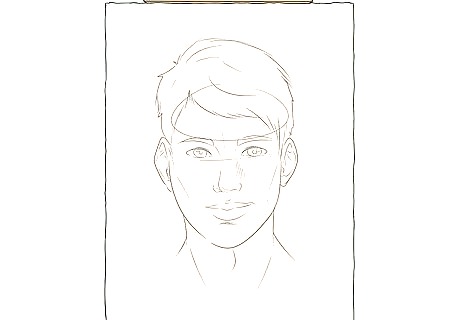
Draw the outlines of the face you want to paint. Whether you’re painting a self-portrait, a friend, a face from a reference photo, or a face you made up in your head, sketching the face on your paper first will make it easier to paint. Use a pencil to lightly draw the face onto your paper or canvas. Outline the different features of the face, including the eyes, eyebrows, nose, and lips. Draw the hair and ears too. Don’t shade in your drawing. You just want the outlines of the face on your paper or canvas.
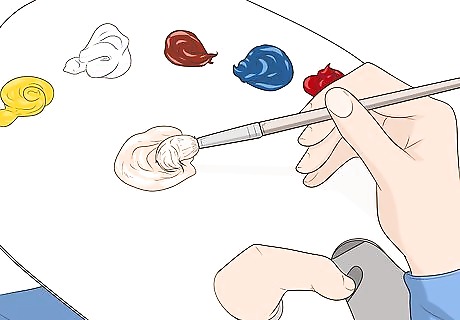
Blend paints together on a pallet to create the right skin tone. The right skin color for your portrait will depend on the subject’s natural skin tone and the lighting you’re painting the subject in. There’s no single recipe for mixing skin tone. Instead, you’ll need to use a palette of several colors and experiment with mixing them together on your paint pallet until you get the right tone. For a color palette you can start with, use Titanium White, Cadmium Yellow Light, Burnt Umber, Ultramarine Blue, and Alizarin Crimson. Mix together two colors in your palette, then compare that color to your subject’s skin tone. If it’s too yellow, you might try toning it down with Burnt Umber. If it’s too dark, you might add some Titanium White. For a cooler skin tone, you could add more Ultramarine Blue. Keep experimenting like this until you find the right skin tone. Squeeze paint on your pallet only when you’re ready to use it so it doesn’t dry out. Acrylic paints dry fast, so it’s best to work with one color (or set of colors if you’re blending) at a time. Only squeeze enough paint out of the tube as you can work with at once.
Painting Your Portrait
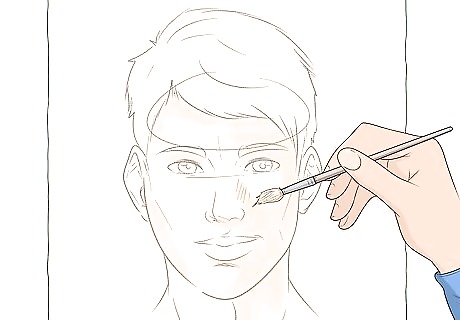
Fill in the skin with one of your larger brushes, then add more detail. Use the paint you blended to fill in the outline of the face. Remember that the skin won’t be the same shade all over. There will be darker and lighter areas. Add black, white, and browns to the skin tone you created for these areas. Start by blocking in the general shades of the skin. Then, continue to go over it with your smaller brushes, adding new shades and colors where you see them. The amount of time you spend on this and the types of strokes you use will depend on the level of detail and the style you’re going for. Human skin is complex. There may be colors in your subject’s skin that you wouldn’t expect, like purples, blues, greens, and reds. The more shades and colors you add, the more dynamic and realistic your portrait will look.
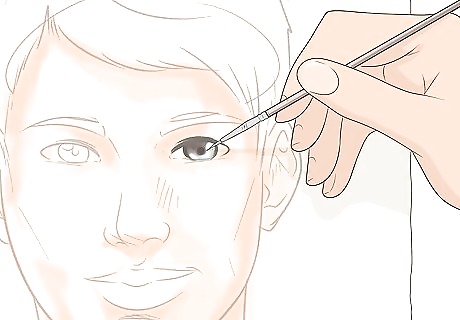
Paint the eyes using a small brush. First, fill in the pupils and outline the irises and lash lines using black. Leave a white dot in each pupil so it looks like the light is reflecting off the eyes. Then, block in the irises with a color that matches your subject’s eye color. You’ll need to experiment with blending different colors together to find the right shade. Paint the inner corners of the eyes, and shade in the whites around the eyes too. Look closely at your subject, and you’ll probably find that the area around their irises isn’t stark white. It might be gray, or it could have a reddish hue. Once you’ve blocked in the main colors of the eyes, go back in with one of your smallest brushes and add finer details, like shading within the irises. Spend extra time on the eyes. Painting eyes that are realistic and dynamic can really bring your acrylic portrait to life.
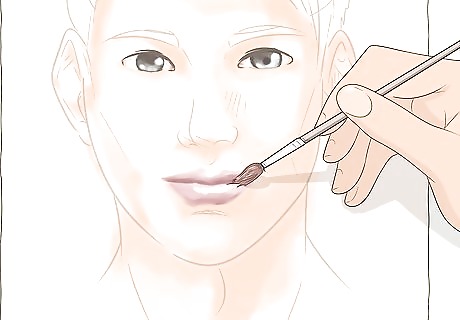
Blend the right lip tone and paint the mouth. Outline the bottom of the upper lip and the top of the lower lip with black. Then, blend colors together until you achieve your subject’s lip tone, and block in both lips with that color. Add detail to the lips, like shading at the corners and highlights wherever they appear on your subject’s lips. Usually, you’ll notice highlights above and below the lips and along the middle of the lower lip. If your subject’s mouth is open, leave the teeth white, paint the gums, and shade in the corners of the mouth. Avoid outlining the teeth with black since it can create the appearance of gaps. Instead, using subtle shading to make the teeth look three-dimensional.

Paint the nose. At this point, the nose should be filled in with a base layer of paint you blended for the skin tone. Paint in the nostrils using black or a deep brown color. Then, add highlights and shadows to refine the shape of the nose and give it more structure. Generally, the skin on the nose will appear lighter on the bridge, tip, and edges of the nostrils, but reference your subject to find where the highlights and shadows fall on the face. Depending on the lighting and your subject’s complexion, there may be other colors in the nose as well. For example, there could be a rosy hue at the tip of the nose. In that case, you could blend a little red into the skin tone color you created.
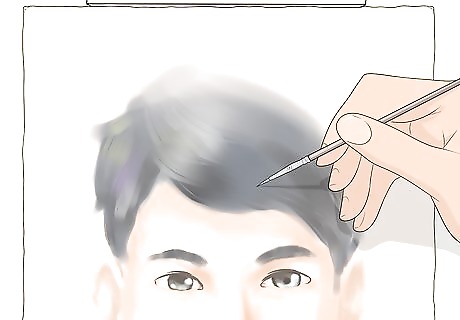
Block in the hair using a larger brush, then add finer details. First, blend colors together until you achieve your subject’s base hair color. Then, fill in the outline of the hair, including the eyebrows if they’re the same color, with that color. Paint in the direction the hair flows in to give it a realistic movement. Once you’ve blocked in the hair, add more layers of paint, including highlights and shadows that are visible in the hair. Alternate between different size and material brushes here to create the appearance of both thick clumps of hair and thin, individual strands. The more layers you add to the hair, the more dynamic and realistic it will look. Similar to skin, human hair can contain a variety of surprising colors, like blues, reds, and purples, depending on the lighting. Closely examine your subject’s hair, and play around with adding different colors to help bring the hair to life.
Finishing Your Portrait
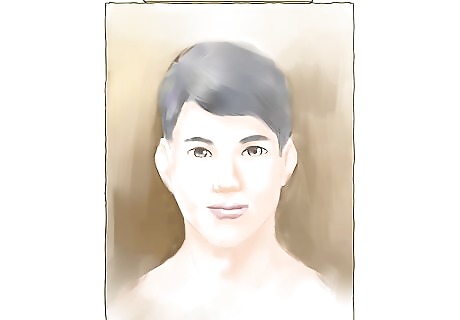
Paint the background of your portrait. Painting the background last allows you to create a crisp, clean background around the face you’ve painted. Use a larger brush to fill in most of the background, then go around the edges of the hair and face with a smaller brush. When choosing a color for your background, you might go with a color that complements your portrait. For example, matching the background to the color of your subject’s eyes may look nice. Alternatively, you can choose a contrasting color to really make your portrait pop. For example, if your subject has striking blue eyes, you could paint the background yellow to contrast them.
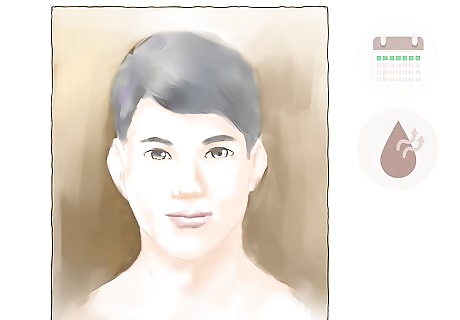
Let your acrylic portrait dry for at least 1 week if you plan on applying varnish. Acrylics dry quickly, but it can take a week or even longer for all of the layers of acrylic paint in a portrait to dry enough for varnish. If you apply varnish before the paint is fully dry, it could look cloudy because of the moisture trapped underneath. If you’re not varnishing your painting, it should be dry enough to touch within a few hours.

Varnish your painting to protect it and enhance the colors. Varnishing isn’t necessary, but it does help protect acrylic from dust, sun damage, and yellowing. It can also add a nice finish to your painting and bring out the colors. Just mix the varnish according to the instructions, and apply it to the surface of your painting with a brush. Then, let the varnish dry. You may need to apply multiple coats depending on the type of varnish you’re using. You can purchase varnish at your local arts and crafts store.


















Comments
0 comment